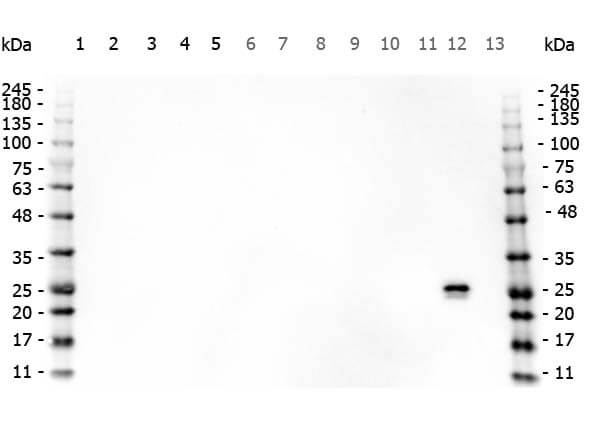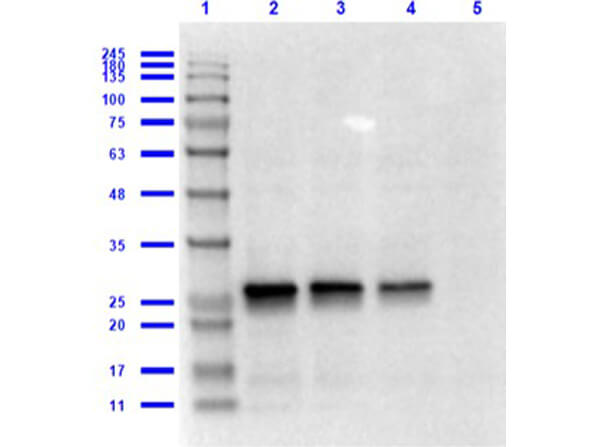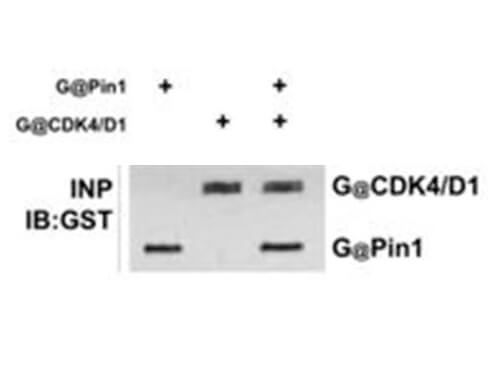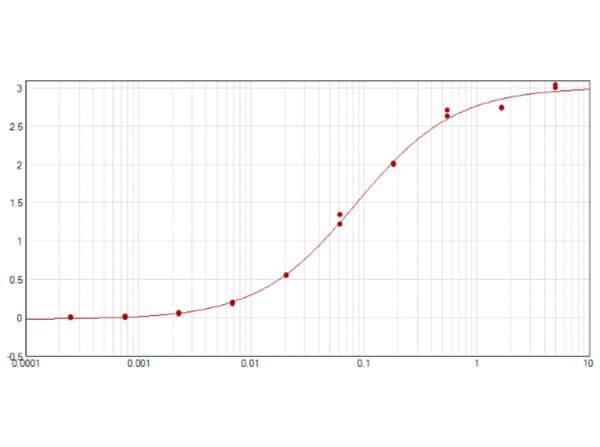GST Antibody
Goat Polyclonal
15 References
600-101-200S
600-101-200
25 µL
1 mg
Liquid (sterile filtered)
Liquid (sterile filtered)
WB, ELISA, IP, Other
GST-Tag
Goat
Shipping info:
$50.00 to US & $70.00 to Canada for most products. Final costs are calculated at checkout.
Product Details
Anti-GST (GOAT) Antibody - 600-101-200
goat anti-GST antibody, Glutathione-S-Transferase
Goat
Polyclonal
IgG
Target Details
GST-Tag
Native Protein
Glutathione-S-Transferase [Schistosoma japonicum]
This product was prepared from monospecific antiserum by immunoaffinity chromatography using GST coupled to agarose beads followed by solid phase adsorption(s) to remove any unwanted reactivities and extensive dialysis against the buffer stated above. Assay by immunoelectrophoresis resulted in a single precipitin arc against anti-Goat Serum as well as purified and partially purified Glutathione-S-Transferase [Schistosoma japonicum]. Cross reactivity against Glutathione-S-Transferase from other sources may occur but has not been specifically determined.
P08515 - UniProtKB
Application Details
ELISA, WB
IP, Other
- View References
Anti-GST has been tested by ELISA and western blot and is suitable for immunoblotting (western or dot blot), ELISA, immunoprecipitation and most immunological methods requiring high titer and specificity. This antibody has also been reported to be suitable for immobilization in Label-free Interaction Analysis (Biocore).
Formulation
1.06 mg/ml by UV absorbance at 280 nm
0.02 M Potassium Phosphate, 0.15 M Sodium Chloride, pH 7.2
0.01% (w/v) Sodium Azide
None
Shipping & Handling
Wet Ice
Store GST antibody at 4° C prior to opening. Centrifuge product if not completely clear after standing at room temperature. This product is stable for several weeks at 4° C as an undiluted liquid. Dilute only prior to immediate use. For extended storage aliquot contents and freeze at -20° C or below. Avoid cycles of freezing and thawing.
Expiration date is one (1) year from date of receipt.
Rockland produces a wide range of GST antibodies in our laboratories. Select GST antibodies from several monoclonal and/or polyclonal GST antibodies listed below. Select appropriate GST antibodies for your research by isotype, epitope, applications and species reactivity. GST (Glutathione-S-Transferase) is a protein expression tag commonly used in molecular biology. Anti-GST will react with synthetic construct present in most known GST containing cloning or expression vectors. GST is responsible for the conjugation of reduced glutathione to a wide number of exogenous and endogenous hydrophobic electrophiles. The amino acid sequence GST is highly conserved in most organisms including mammals. GST exists as a 26 kDa homodimer.
Arasawa T et al. (2023). Analysis of patients with colorectal cancer shows a specific increase in serum anti-ING1 autoantibody levels. BMC Cancer.
Applications
WB, IB, PCA
Lorenz, P et al. (2022). The KRAB Domain of ZNF10 Guides the Identification of Specific Amino Acids That Transform the Ancestral KRAB-A-Related Domain Present in Human PRDM9 into a Canonical Modern KRAB-A Domain. International Journal of Molecular Sciences
Applications
WB, IB, PCA
Kubota M et al. (2022). Serum anti‑TSTD2 antibody as a biomarker for atherosclerosis‑induced ischemic stroke and chronic kidney disease. Med Int (Lond).
Applications
WB, IB, PCA
Koivunen, J et al. (2021). Integrin α11β1 is a receptor for collagen XIII. Cell and Tissue Research
Applications
SPR-Based Analyses
Kubota, M et al. (2021). Serum anti-SERPINE1 antibody as a potential biomarker of acute cerebral infarction. Scientific Reports
Applications
WB, IB, PCA
Meusser B et al. (2020). HIV-1 Gag release from yeast reveals ESCRT interaction with the Gag N-terminal protein region. J Biol Chem.
Applications
WB, IB, PCA
Licht et al. (2019). Inosine induces context-dependent recoding and translational stalling. Nucleic Acids Research
Applications
WB, IB, PCA
Yoshida, Y et al. (2018). Elevation of autoantibody level against PDCD11 in patients with transient ischemic attack. Oncotarget
Applications
WB, IB, PCA
Bolch, SN et al. (2016). A Splice Variant of Bardet-Biedl Syndrome 5 (BBS5) Protein that Is Selectively Expressed in Retina. PloS One
Applications
IP, Co-IP
Pitoniak et al. (2015). Cdc42p-interacting protein Bem4p regulates the filamentous-growth mitogen-activated protein kinase pathway. Molecular and Cellular Biology
Applications
WB, IB, PCA
Machida et al. (2015). Identification of stroke-associated-antigens via screening of recombinant proteins from the human expression cDNA library (SEREX). Journal of Translational Medicine
Applications
E, EIA; SDS, 2D-PAGE; WB, IB, PCA
Hang I et al. (2015). Analysis of site-specific N-glycan remodeling in the endoplasmic reticulum and the Golgi. Glycobiology
Applications
Undefined
Smith, TS et al. (2013). Light-dependent phosphorylation of Bardet-Biedl syndrome 5 in photoreceptor cells modulates its interaction with arrestin1. Cellular and Molecular Life Sciences : Cmls
Applications
WB, IB, PCA; IP, Co-IP
Karunanithi S et al. (2012). The Filamentous Growth MAPK Pathway Responds to Glucose Starvation Through the Mig1/2 Transcriptional Repressors in Saccharomyces cerevisiae. Genetics.
Applications
WB, IB, PCA
Rizzolio F et al. (2012). Retinoblastoma tumor-suppressor protein phosphorylation and inactivation depend on direct interaction with Pin1. Cell Death Differ.
Applications
WB, IB, PCA
This product is for research use only and is not intended for therapeutic or diagnostic applications. Please contact a technical service representative for more information. All products of animal origin manufactured by Rockland Immunochemicals are derived from starting materials of North American origin. Collection was performed in United States Department of Agriculture (USDA) inspected facilities and all materials have been inspected and certified to be free of disease and suitable for exportation. All properties listed are typical characteristics and are not specifications. All suggestions and data are offered in good faith but without guarantee as conditions and methods of use of our products are beyond our control. All claims must be made within 30 days following the date of delivery. The prospective user must determine the suitability of our materials before adopting them on a commercial scale. Suggested uses of our products are not recommendations to use our products in violation of any patent or as a license under any patent of Rockland Immunochemicals, Inc. If you require a commercial license to use this material and do not have one, then return this material, unopened to: Rockland Inc., P.O. BOX 5199, Limerick, Pennsylvania, USA.




